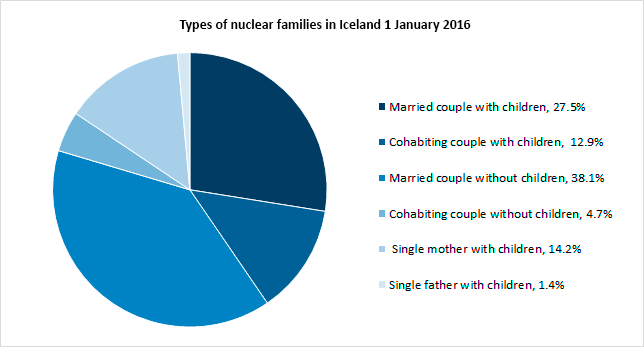The total population of Iceland 1 January 2016 was 332,529 compared with 329,100 in 2015. This constitutes an increase of 1%. The population declined in three regions, primarily in the Westfjords which lost 1.2% of its population in 2015. Five regions experienced a population increase. The region of Suðurnes gained proportionally the most (2.2%), its population increasing by 466 persons. The population increased in the capital region by 1.1%.
The number of municipalities 1 January 2016 was 74, same as in the previous year. Six municipalities had fewer than 100 inhabitants, 41 had fewer than 1,000 inhabitants and only nine municipalities had more than 5,000 inhabitants.
The number of nuclear families, i.e. couples with or without children under the age of 18 years or single parents with children under 18 years, was 79,870 on 1 January 2016, compared with 79,356 families one year earlier. The distribution of the main types of nuclear families is presented in the following figure.

The dependency ratio was 68.1% 1 January 2016, while 68.4% in the previous year. The dependency ratio is calculated as the ratio of the young and old age population relative to the working age population (defined as 20–64 years of age).
Methods
The definition of localities and urban nuclei is in alignment with international recommendations, especially that of the Commission Regulation (EC) No 1201/2009 implementing Regulation (EC) No 763/2008 of the European Parliament and of the Council on population and housing censuses as regards the technical specifications of the topics and of their breakdowns.